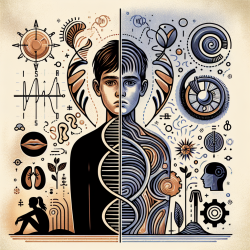Introduction
In the realm of speech-language pathology, the integration of music therapy holds transformative potential, especially for children with developmental cerebellar anomalies (DCA). Recent research titled "Musical abilities in children with developmental cerebellar anomalies" provides insightful data on how music perception and production are affected in these children. This blog delves into the study's findings and explores how practitioners can harness these insights to foster improved outcomes for children with DCA.
Understanding the Study
The study investigated musical abilities in children with DCA, focusing on rhythm and melody perception, as well as music production through singing tasks. Sixteen children with DCA were compared to 37 healthy controls using the Montreal Battery for Evaluation of Musical Abilities (MBEMA) and singing tasks. The results revealed significant impairments in rhythm perception and melodic reproduction among children with DCA, highlighting the cerebellum's role in rhythm processing and the vocal sensorimotor loop.
Key Findings and Implications
- Rhythm Perception Deficits: Children with DCA exhibited significant challenges in rhythm perception, underscoring the cerebellum's critical role in rhythm processing.
- Melodic Reproduction Challenges: The study found that children with DCA struggled with reproducing melodies, which was linked to their rhythm perception abilities.
- Correlation with Oro-bucco-facial Praxis: A strong correlation was observed between singing abilities and oro-bucco-facial praxis, suggesting that motor coordination plays a vital role in musical production.
Practical Applications for Practitioners
For practitioners working with children with DCA, these findings offer a pathway to tailor interventions that leverage music therapy. Here are some strategies to consider:
- Focus on Rhythm-Based Activities: Incorporating rhythm-based exercises can help improve timing and coordination, potentially enhancing both motor and cognitive functions.
- Utilize Singing and Vocal Exercises: Engaging children in singing activities can support the development of the vocal sensorimotor loop, improving both speech and musical abilities.
- Consider Individual Profiles: The study highlights the heterogeneity among children with DCA, suggesting that personalized interventions based on individual strengths and challenges are crucial.
Encouraging Further Research
While the study provides valuable insights, further research is needed to explore the specific mechanisms underlying musical deficits in children with DCA. Future studies could investigate the role of different cerebellar regions in rhythm perception and production, as well as the potential benefits of long-term music therapy interventions.
To read the original research paper, please follow this link: Musical abilities in children with developmental cerebellar anomalies.










